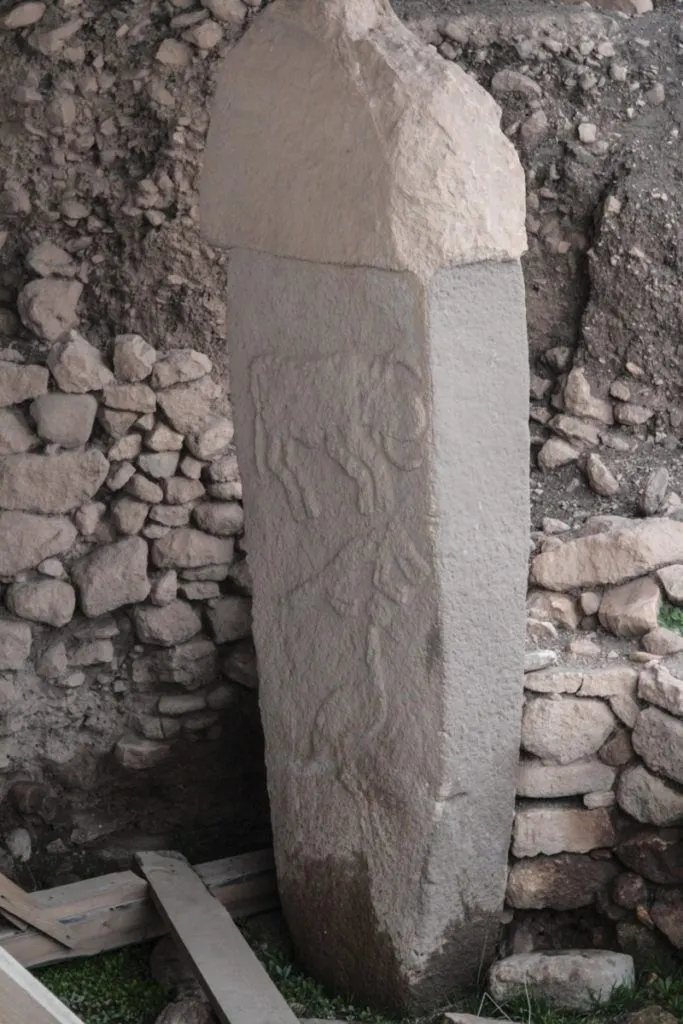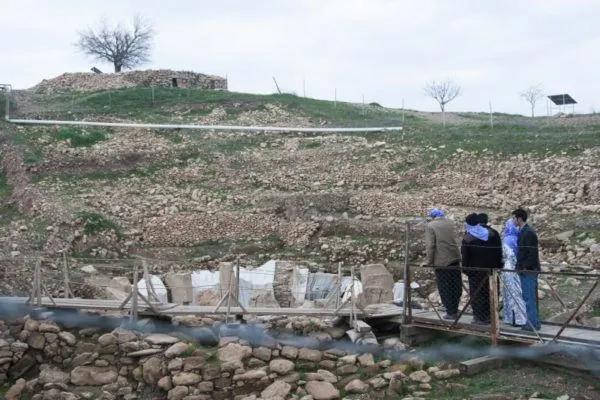Gobekli Tepe, Earth’s oldest religious temple is on a remote hillside east of Sanliurfa. It has challenged and shaped theories of ancient civilizations and is a must visit when touring southeast Turkey.
The first time we visited Göbekli Tepe, we drove through the dust from Şanliurfa, a Muslim pilgrimage site where Abraham was born and killed. Even though the roads are paved, the barren landscape cannot hold back the wind, which can be very strong and carries with it plenty of dust, heat, and history.

It’s only about 15 kilometers, but it’s a long, slow, almost boring 15 kilometers. It is so deserted that we were thrilled to come upon a small band of boys riding their donkeys and tending their sheep. We stopped and attempted a chat with them, but as boys usually do, it was more teasing and laughing and wanting their photos taken. Oh, by the way, did we have any candy?

We turned and a mere two kilometers up a slight incline we found ourselves looking out over the hill. The tell (human made mound that covers archaeological treasures), where a mysterious and relatively new site is emerging stone after stone, is reshaping history.
Prior to the discovery of Göbekli Tepe in the 1960s and the start of excavations in 1995, Çatalhüyük was regarded as the oldest organized city (7500 BCE), and the Egyptian pyramids (Egypt), Ħaġar Qim (Malta) and Stonehenge (United Kingdom) as well as a few other sites, were known as the first temples of organized religion. The earliest of which were begun around 2500 BCE, however Göbekli Tepe has been carbon-dated to about 11,000 BCE–thousands of years before any of the others.

We had heard rumors that sometimes the site was not open, and we certainly weren’t getting there during tourist season, so we were happy to see that there was one bekçi (caretaker) there with his son, and we were able to wander all over the site with him following along.
In many Turkish archaeological sites, you are free to climb over, rummage through, and basically do whatever you want (without hurting anything), but the bekçi here must have been under strict orders not to let anyone go anywhere but the beaten path up to the fenced enclosures. Luckily, the stones were mostly uncovered and we clearly saw the bas-relief carvings on the stone pillars.

There is something thrilling and exciting about a deserted archaeological site. The breeze whispers stories and hints of the past. You can almost hear the swishing of footsteps of the priests as they waddle through the stones, arranging a feast or funeral pyre, or setting out the bones of the deceased for the vultures to pick clean. Our small party wandered among the pillared circles, marveling at how many animals we recognized and developing our own theories for their meanings.

Archaeologists continue to rethink how this site came to be. Previously they thought that people who lived at this time were hunter-gatherers who only used rudimentary tools. How did they organize to build the stone circles? Who led them? Where did they live? How did they carve such intricate likenesses of these animals without the development of carving tools?
It is thought that the people would erect a circle for some time, use it then bury it, and build another circle. Did it lose its magic? Klaus Schmidt (the lead archaeologist from Germany) believes he will find a burial ground somewhere near the pits, but so far has only found animal remains and jugs that could have held beer. Maybe the people only came here to have a great feast or festival. While we were there we let our imaginations wander and we enjoyed it tremendously.

The site is very small, and some pits are very dark due to the corrugated metal covering that protects them from the elements. These covers are important to preserve the artifiacts, but they can also be somewhat of a hindrance, especially for getting well-lit photographs.
We’d been wandering for about an hour when another small group of tourists arrived. They were from Syria, which is very close. Even though we had no common language, we shook hands, chatted (mostly in gestures), took some photos and went about our own ways. Their dress suggested they were Muslims, but they were just as interested in the site and the stone pillars as we were.
At that point the sun began to set and the bekçi started to hurry us to the exit so he could get home to dinner. As one of the theories is that the stone circles represent worship of the Dog Star, Sirius, I would have loved to stay long into the night; instead we headed out looking for our night’s accommodation a few kilometers away.
If you want to go to Göbekli Tepe, you must understand a few things. It is a very new and small site. The scientists and organizers cover and uncover the different pits depending on their needs, not necessarily the needs of tourists. The site is very close to the Syrian border, and there are refugee camps very close to the area so the Turkish government has warned tourists that there could be trouble in the vicinity.
There are plenty of other sights to see in the area such as Gaziantep, Şanliurfa, and further east Mardin and Diyabakir. Harran, the home of the beehive houses, is the closest site at only a few kilometers down the road as well and worth the trip if you are going.
Probably the best way to get there would be to take a tour, but it is also very possible to drive or hire a private taxi to take you.
To learn more about Göbekli Tepe, you can go to these websites:
Göbekli Tepe, The World’s First Temple
Have you been to Southern Turkey? Göbekli Tepe? If so, we’d love to hear your thoughts on travel in this region. Leave a comment below.
Author Bio: Corinne Vail is a travel photographer, food lover, and a perpetual traveler who has been travel writing for over 14 years. For many years she lived overseas in Germany, Japan, Turkey, South Korea, and the Netherlands teaching the children of the US. military. She’s visited over 90 countries, and she’s not stopping anytime soon.

Sophie
Friday 24th of January 2014
How interesting. I love obscure little places like this that turns out to be so significant, yet that I've never even heard of. So much more of Turkey I need to see.
Corinne Vail
Friday 24th of January 2014
Yes Sophie. Göbekli Tepe is fascinating, and I really enjoyed the other places around there as well.
The Guy
Tuesday 21st of January 2014
This looks like a fascinating place. The ruins are in such good condition, well at least the ones in your picture. I would also enjoy being there when it is not so crowd such as the time when you visited.
It is amazing how long religion in its various forms has been with us.
Corinne Vail
Wednesday 22nd of January 2014
I found it to be a fascinating site. I was lucky that many of the columns were uncovered the first time. The second time more were covered up, but I still thought it was an impressive site.
Natalie
Tuesday 21st of January 2014
I was actually quite disappointed with it, which horrifies a lot of people. Still to publish my article and not quite sure what to say
Corinne Vail
Wednesday 22nd of January 2014
I think if you read the National Geographic article before going, you would be disappointed. We went the first time before the article was published, and the second time after with different people. The two groups had significant reactions. Interesting.